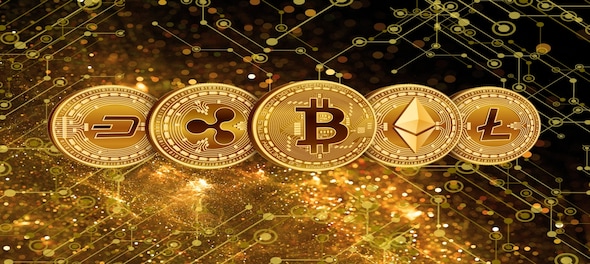
Decentralised Finance (DeFi)
One of the most popular and important trends observed in the cryptocurrency sector is decentralized finance (DeFi). DeFi is a concept that encompasses an ecosystem of financial services and products built on blockchain networks.
The DeFi space has witnessed remarkable growth in the past few years. According to DefiLlama, the total value locked (TVL) in DeFi protocols stood at $15 billion at the beginning of 2021 but soared to $166 billion by the year's end. However, since then, DeFi valuations have struggled to match earlier levels due to weak crypto prices.
Nonetheless, the same has not stopped the emergence of new projects, protocols, and offerings within the DeFi sector. Recently, the most notable developments in DeFi include cross-chain interoperability and layer-2 solutions.
Both concepts enhance blockchain networks, bringing in several benefits that were previously inaccessible. In short, cross-chain interoperability enables decentralized applications (dApps) in different blockchains to interact with each other. Meanwhile, layer-2 solutions help blockchain networks improve speed and efficiency.
NFTs
Non-fungible tokens are a form of expression that is represented digitally. Although NFTs were first created in 2014, it wasn’t until 2021 that the boom took off. Digital NFT collections ushered in a new era for graphic designers, artists, businesses, and art collectors. However, the versatile nature of NFTs has managed to captivate various industries, corporations, and even individuals.
Renowned brands such as Starbucks, Ford, Louis Vuitton, Nike, Adidas, and many others have dipped their feet in the NFT pool. Meanwhile, celebrities like Bella Hadid, Justin Bieber, and Snoop Dogg have made headlines for buying NFTs or launching their collections. The applications of NFTs are endless.
For instance, the gaming industry embraced the concept, allowing gamers to own and trade their in-game items, victory badges, and achievements on blockchain platforms as NFTs. Meanwhile, its application is even evident in niche scenarios. For example, NFT tickets are a popular concept that provides access to exclusive events and experiences, such as concerts, sports events, and festivals.
DAOs
Decentralized autonomous organizations (DAOs) represent blockchain-based entities that operate autonomously, free from the control or interference of any central authority or third party. These organisations rely on a combination of on-chain and off-chain mechanisms and are constructed upon automated rules encoded in smart contracts.
The DAO model has gained significant popularity within the Web3 space, primarily due to its ability to foster decentralization, transparency, and support for non-profit organisations with global accessibility.
In a DAO, governance is entrusted to its members, each of whom possesses control over the decision-making process and the ability to propose changes or upgrades. As the DAO operates on a blockchain, any alterations to the network require the approval of all participating members through a voting system. To facilitate this, each DAO typically has its governance token, granting holders the right to participate in decision-making processes.
One of the key advantages of DAOs lies in their global accessibility and flexibility when compared to traditional corporate models. With lower barriers to entry, DAOs have flourished within the Web3 space, finding widespread adoption across various decentralised finance (DeFi) protocols.
CBDCs
You may have heard that several countries, including Sweden, China, and the Bahamas, are planning to, or have already launched their Central Bank Digital Currencies (CBDCs). CBDCs are specifically designed to serve as digital legal tender, aiming to enhance financial inclusion and payment systems. CBDCs possess the potential to simplify and reduce the costs of large-scale international payments, just like cross-settlement cryptocurrency platforms have.
Blockchain and AI
The combination of blockchain and AI has several applications for cryptocurrencies. One notable application is data marketplaces, which serve as platforms for the secure buying and selling of data. By leveraging blockchain and AI, these marketplaces can ensure data authenticity, provenance, and quality, while also providing incentives and rewards to both data providers and customers.
Additionally, the concept of Artificial Intelligence of Things (AIoT) refers to a network of interconnected physical devices capable of communication. AIoT can be integrated with decentralised platforms that facilitate the storage, collection, and management of data. This convergence opens up innovative solutions for various sectors, including smart homes, healthcare, agriculture, and more.
Conclusion
Blockchain can enhance efficiency, reduce costs, and enable new business models and opportunities within the cryptocurrency industry. However, along with its benefits, there are challenges to address, such as scalability, regulatory frameworks, and energy consumption.
Hence, the industry’s future success depends upon how it can combat these looming challenges and scale up in the coming years.
Check out our in-depth Market Coverage, Business News & get real-time Stock Market Updates on CNBC-TV18. Also, Watch our channels CNBC-TV18, CNBC Awaaz and CNBC Bajar Live on-the-go!


Supreme Court says it may consider interim bail for Arvind Kejriwal due to ongoing Lok Sabha polls
May 3, 2024 4:57 PM
10% discount on fare on Mumbai Metro lines 2 and 7A on May 20
May 3, 2024 2:40 PM

